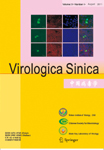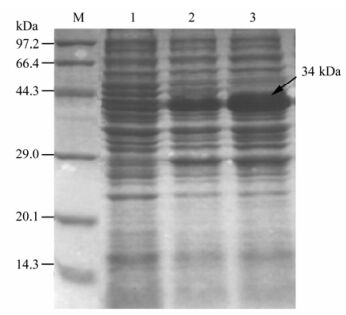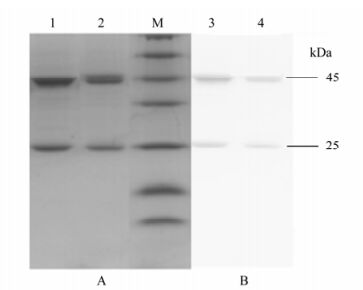-
Foot-and-mouth disease (FMD) is a highly contagious vesicular disease of cloven-hoofed animals. Foot-and-mouth disease is the most economically significant infection of domestic livestock. It causes production losses, particularly to the dairy and pig industries and is a major constraint in the international trade of live animals and their products. Its pathogen is foot-and-mouth disease virus (FMDV) which is a member of the genus Aphthovirus and of the family Picornavidae and includes seven serotypes. Serotype A is widely distributed and very active in the Middle East and Asia [8].
Monoclonal antibodies (mAbs) have been widely used in infectious diseases research, diagnosis and therapy. Compared to the tests based on polyclonal anti-sera, diagnostic tests with mAbs always have higher specificity, accuracy and efficiency [10]. In this study, we report the generation of an anti-FMDV A Type mAbs. Two mAbs 7B11 and 8H4 were screened after immunization of mice with A Type FMDV. The specificity, stability, titers and neutralization activity of the mAbs were analyzed.
HTML
-
The A/AV88 virus strain (isolated in Russia in 1958) and FMDV O, Asia1 and C serotypes and swine vesicular disease virus (SVDV) used in this study were reference strains obtained from the National Foot and Mouth Disease Reference Laboratory, Lanzhou Veterinary Research Institute, Chinese Academy of Agricultural Sciences.
SP2/0 cells were purchased from ATCC (Manasa, VA) and were cultured in EX-CELL® CD Hybridoma Medium(sigma)supplement with 10% fetal calf serum. BHK-21 cells were preserved by LVRI and cultured in DMEM supplement with 10% fetal calf serum.
Complete Freund's adjuvant, incomplete Freund's adjuvant, Horseradish peroxidase, Tetramethylbenzidine and Dimathyl sulfoxide (DMSO) were purchased from Sigma Chemical Co., USA.
-
Baby hamster kidney 21 cells (BHK-21) were used for all strains of FMDV. The virus infected BHK-21 cells were cultured in Glasgow's MEM (Alpha MEM was used for LK cells) supplemented with 2 mmol/ L glutamine and 50 mg/mL genta-mycin. Viruses were harvested 24 h post-infection and clarified by centrifugation at 3 500 r/min for 30 min. About 10 mmol/L 2-bromo-ethylamine hydrobromide (BEI) was used to inactivate viruses for 24 h at 37℃. After 24 h, any remaining BEI was inactivated using sodium thiosulphate to a final concentration of 2% [1]
-
Female BALB/C mice 5-6 weeks old were immunized subcutaneously with 20 mg of purified A Type VP1 protein in an equal volume of complete Freund's adjuvant [5]. Three identical boosters emulsified in incomplete Freund's adjuvant were given at 4 week intervals. Mice were boosted with the same antigen in PBS by intraperitoneal injection 3-4 days before fusion. The two immunized mice used for each fusion were sacrificed by overdose anaesthesia. A single-cell splenocyte suspension was obtained for fusion. 1640 with 10% fetal bovine serum was used for fusion and subcloning. Immunized spleen cells were fused with myeloma cells at 5–10:1 ratio in the presence of 50% polyethylene glycol (Merck). The cells were plated out in semisolid medium (Stem Cell) and incubated at 37℃ in a humidified 5% CO2 atmosphere [2]. After 2 weeks, single colonies were transferred to 96-well culture plates. Hybridoma supernatants were screened using an indirect ELISA (developed by our Lab). The positive hybridomas were subcloned using the limiting dilution technique. The mAb isotyping was performed using a mouse monoclonal antibody isotyping kit (Isostrip, Roche).
-
The isotype of three mAbs was determined by adding 25 μL of the cell culture supernatant containing 7B11 and 8H4, respectively, with 200 μL assay buffer to wells coated with each of the rabbit anti-mouse antibodies from the mouse MonoAb ID kit (Sigma) against IgG1, IgG2a, IgG2b, IgG3, IgA and IgM. Detection of bound mAb was by goat anti-rabbit IgG-HRP conjugated antibody (Sigma). IEF was performed in IEF gel pH 3-7 (Invitrogen). Electrophoresis was run following the manufacturer's protocol.
-
A 96-well flat-bottomed plate was coated with serially diluted inactivated FMDV A Type cell virus. Plates were then washed three times with PBS (containing 0.05% Tween 20), and then blocked with 1% BSA at 37℃ for 2 h. Two mAbs were added (100 ng/well) and incubated at 37℃ for 2 h. After washing with Tween/PBS, an HRP-conjugated goat anti-mouse IgG (Sigma) was used for detection.
-
Purified (Saturated ammonium sulfate and Sephacry S-300HR) 7B11 and 8H4 were subjected to SDS-PAGE according to the standard method and transferred to 450 nm nitrocellulose membranes (Bio-Rad) for 1 h. The blots were then blocked with Tris-buffered saline (TBS) containing 0.1% (w/v) casein for 2 h at room temperature. After washing three times with TBS, the blots were incubated for 1 h at 37℃ with TBS. The membranes were washed three times with TBS and incubated with goat anti-mouse IgG conjugated to HRP (Bio-Rad Laboratories, Hercules, CA) for 1 h at 37℃. Following the washes with TBS, the plates were incubated with the enzyme substrate solution containing 0.5 mg/mL 4-chloro-1-naphthol, 0.15% (v/v) hydrogen peroxide and 25% (v/v) methanol [3].
-
The standard procedure for microneutralization (MN) assay for the detection of mAb neutralization activity were followed with certain modifications [4]. In general, serial diluted mouse ascitic fluid and equal volume of A/AV88 (100 TCID50) were mixed and incubated at 37℃ for 1 h. Each virus/diluted mAb mixture was then applied to eleven wells of a 96-well microtiter plate. BHK-21 cells 5×104 per well were also added. After incubation for 2 days at 37℃, the fifty percent end point of neutralization titers for A/AV88 were calculated. The amount of virus actually used per well should contain 100 TCID50. Neutralization assays were repeated at least two times [6].
-
The specificity, stability and titers of mAbs were examined by ELISA (the procedure as described previously). For the specificity, the two mAbs were reacted with O, A and C serotypes of FMDV and SVDV. The stability and titers of prepared mAbs were analysed by ELISA in different passaged generations.
Viruses and cells
Preparation of A Type FMDV
Mice immunization and generation of hybridoma cells
Isotying and isoelectric focusing (IEF)
ELISA
Western blot analysis
Neutralization assay
mAbs characteristic analysis
-
The A Type FMDV was purified by one-step affinity purification using glutathione Sepharose 4B as described in Refs [7, 9, 12]. The presence of recombinant protein in the eluted fractions was confirmed by SDS–PAGE. The recombinant A Type FMDV was 34 kDa, which accounted for 30 % of total protein in E. coli lysates (Fig. 1).
-
In this study, two mAbs (7B11 and 8H4) were obtained. All of them were produced from the mice abdominal cavity. SDS-PAGE showed that the molecular weights of the heavy chain and light chain were about 45.0 and 25.0 kDa (Fig. 2A), which was consistent with the predicted molecular weight, and reacted to VP1 protein specifically with Western blot (Fig. 2B).
-
In the neutralization assay, the result indicated that prepared mAbs could inhibit virus strain A/AV88 from infecting BHK-21 cells (Table 1). When the mAbs 7B11 dilution ratio reached 1:1024, 50% of the cells still survived; indicationg that the titers of mAbs were more than 1:1024. For mAbs 8H4 when the dilution ratio reached 1:512, 50% cells still survived; this showed that the titers of mAbs were more than 1:512.

Table 1. Detection of mAbs neutralization titers by virus neutralization test
-
In this test, FMDV O, Asia1 and C Type and swine vesicular disease (SVD) were used to detect the specificity of prepared mAbs. The results indicated that no cross reaction was found with SVD and FMDV O, Asia1 and C Type antigens (Table 2).

Table 2. The results of the cross-reaction test
-
In the isotype test, 7B11 was found to be from IgG1 whereas 8H4 belonged to IgG2b. As shown in Table 3, the ascites titer of mAbs was between 1-2×105. In the stability test, the titers of prepared mAbs were invariably maintained when passaged to thirty generations (as shown in Table 3). All of these results showed that the developed mAbs possessed good specificity and high titers.

Table 3. The ascites titer and stability of the screened monoclonal antibodies
Purification of A Type FMDV protein
mAb production
Neutralization assay
Cross-reaction
Isotype identification
-
In this study we purified the serotype A Type FMDV inactivated virus, vaccinated BABL/c mouse with purified A Type FMDV antigen, fusion spleen cell and SP2/0 cell and screened two strains mAbs. Before fusing to the cell, the antibody titer of the immunized BALB/c mouse showed a titer as high as 1024, which was a good preparation for this test. In this study, we also found that using expressed protein immunized BALB/c is a good strategy to prepare mAb, since this method would avoid the possibility of live virus escaping from laboratories and other places [11].
Two anti-FMDV Asia1 type mAbs, 7B11 and 8H4, were raised and characterized. ELISA and Western blot analysis showed that the prepared mAbs were highly specific to A Type FMDV and did not cross-react with SVD and FMDV O, Asia1 and C Type antigens. Moreover, prepared mAbs were shown to have an excellent neutralizing activity against A Type FMDV. The neutralizing activity of prepared mAbs were at least 1:1024 and 512 (as shown in Table 1, Table 2 and Table 3). Because of this good quality, the prepared mAbs can be used to develop various FMDV Type-independent tests for diagnosis and analysis of the antigen epitopes of FMDV serotype A.















 DownLoad:
DownLoad: